Greek History
1/57
There's no tags or description
Looks like no tags are added yet.
Name | Mastery | Learn | Test | Matching | Spaced |
|---|
No study sessions yet.
58 Terms
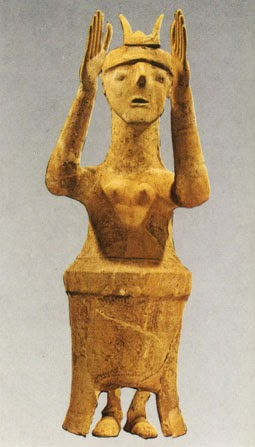
“Godess” figure from karphi ca. 1000 BCE wheel-made and hand-made, arms raised to show shes a goddess
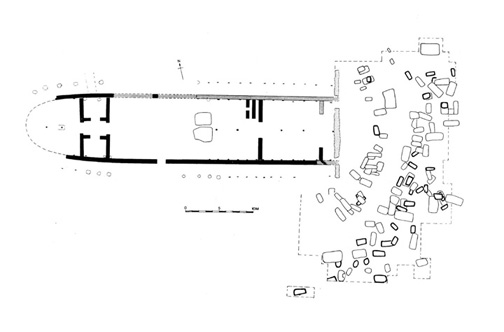
Plan of Heroon (Hero-On) at Lefkandi 10th century BCE with a cemetery on the east side - looks almost like a greek temple (house-like, long, with lots of columns. Was at some point buried (on purpose). Two people are buried inside, and a team of horses. One cremation (likely male) in an imported urn, one skeleton with big gold jewelry. The woman was likely bound and sacrificed at the burial of the male. SO much wealth, probably the local ruler
The cemetery around the house was made a century later, with objects of great wealth not seen in other places in the dark ages.
Centaurs are supposed to be awful beings
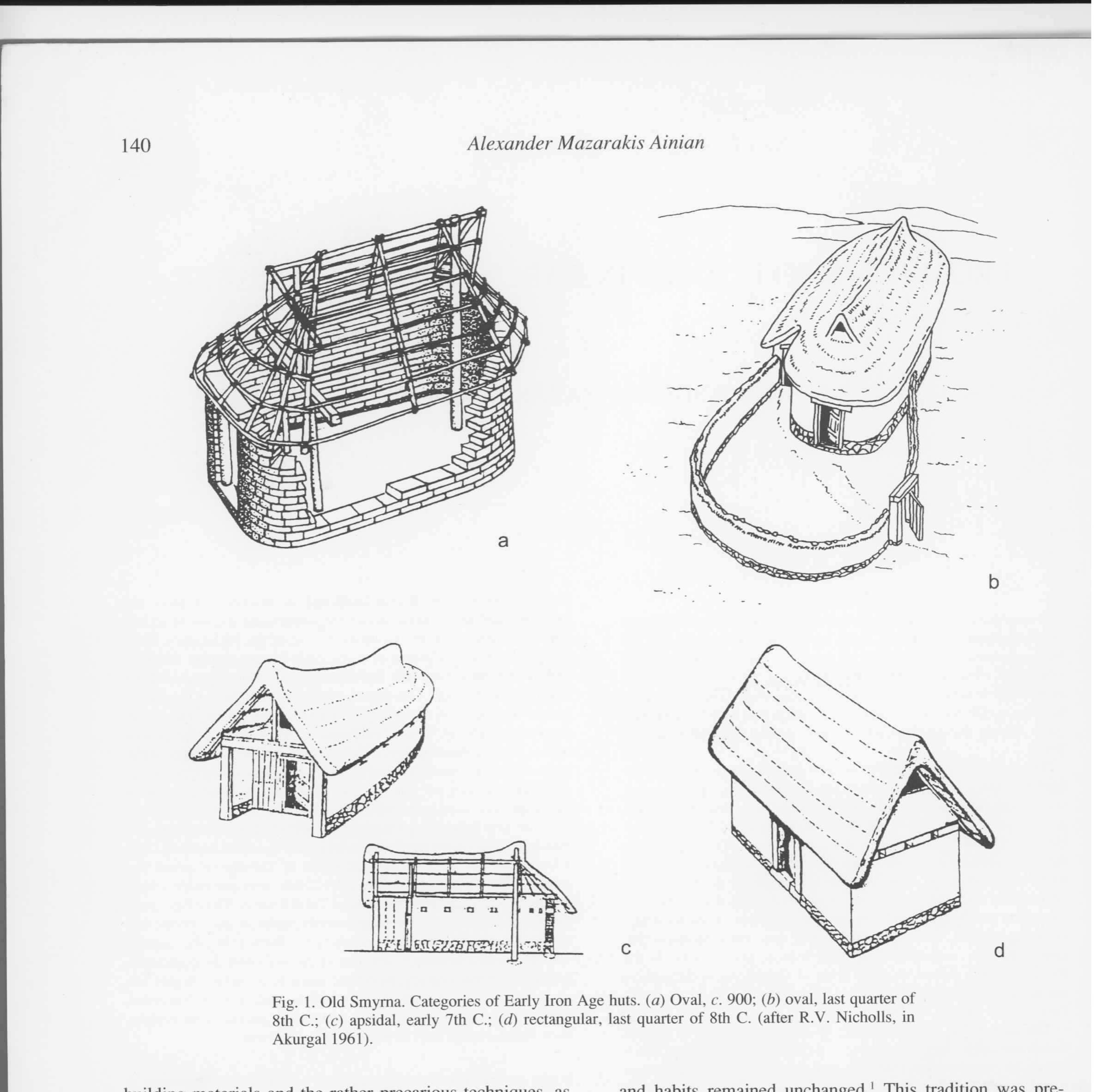
Smyrna (modern Izmir, Turkey), oval hut, 10th century BCE Mud bricks Straw rooves Stone foundation
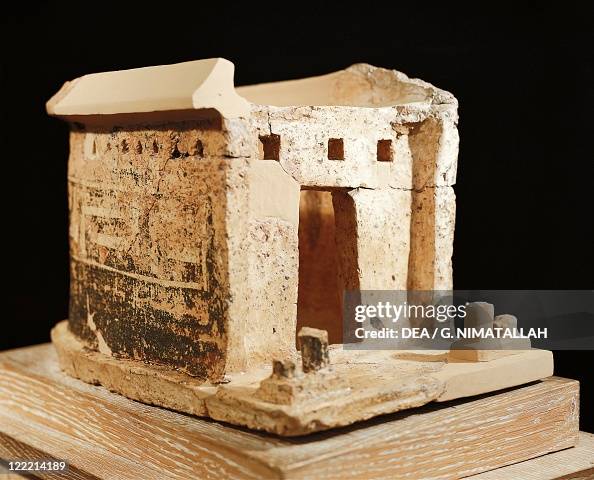
Terracotta votive model of a temple from Perachora 9th century BCE, a terracotta temple built and painted to look like Smyrna huts
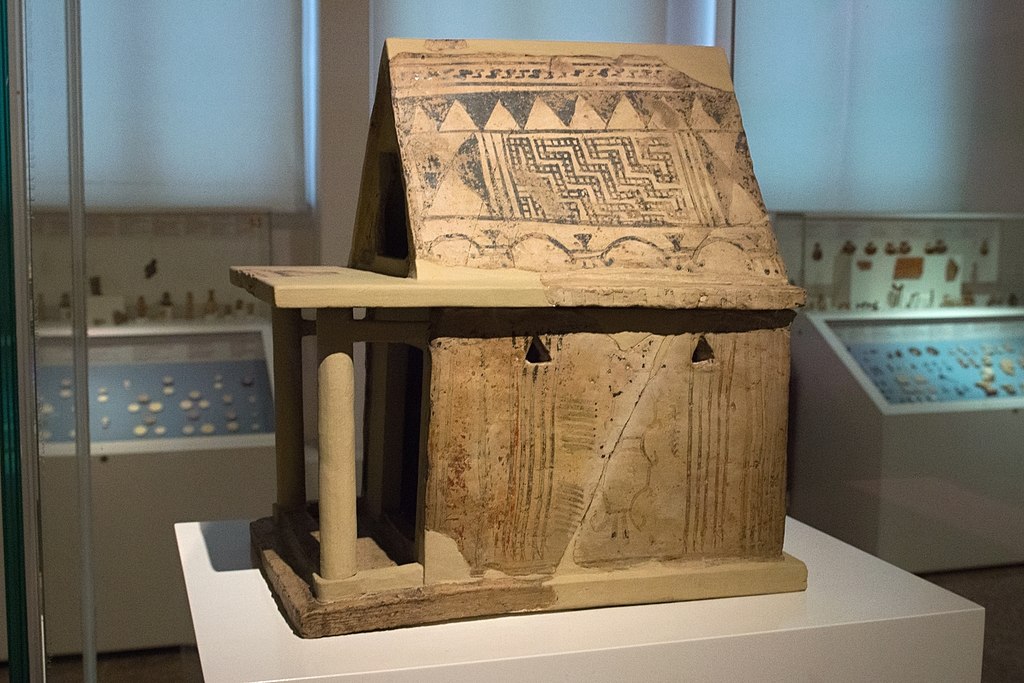
terracotta temple model for Argive Heraion in 8th century BCE, looking less like the Smyrna hut, less rounded
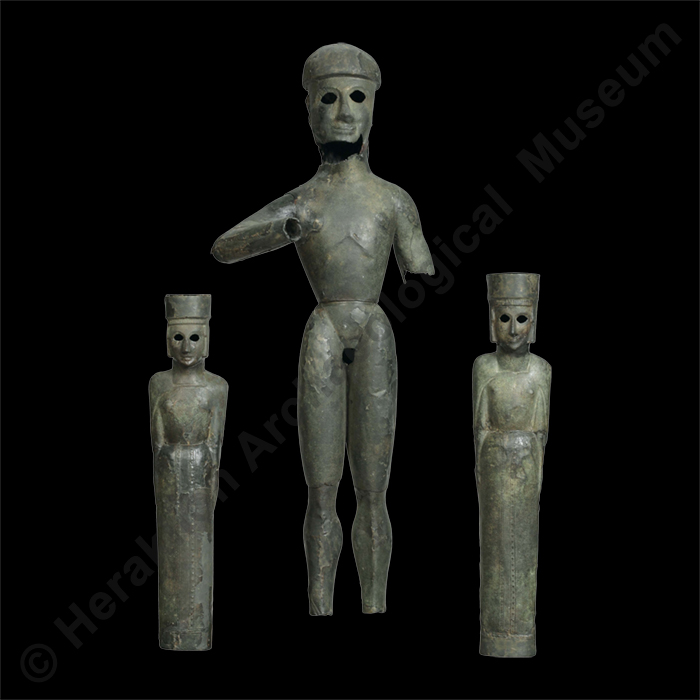
Cult Statues from Dereros, Crete, in the Temple of Apollo, 8th century BCE
Define the concept of the “Dark Age” by describing how it differed from the preceding age. What cultural aspects of the bronze age disappeared at this time? What new ideas were introduced?
In the dark ages what cultural items were lost and what new ones were introduced
Bronze age civilizations of the eastern med reach a crisis and can no longer continue the way they were living, societal collapse
We lose
Writing, lose the bureaucratic society
Cut stone architecture, no more fancy stone
Most luxury goods
International trade
Population
New things
Iron, more iron (iron sucks tho)
Cremation burial
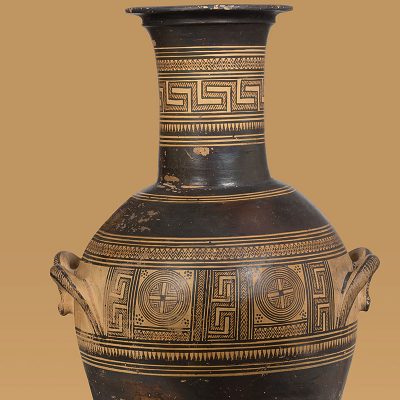
Early geometric amphora, with meander design terracotta
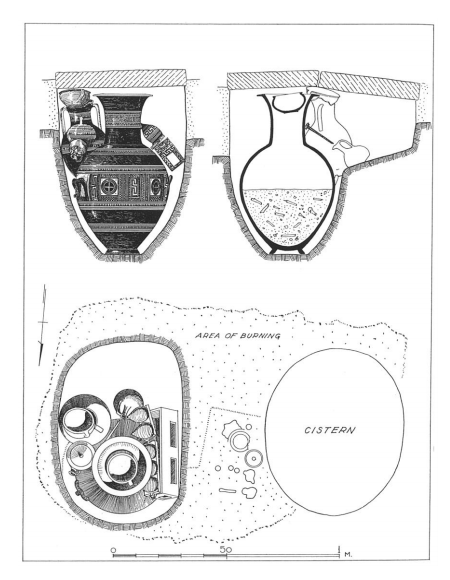
Geometric Period Diagram of the cremation grave of a wealthy athenian lady, vase/urn is 3ft tall and is from the Mid-geometric period cause it has slightly more designs.
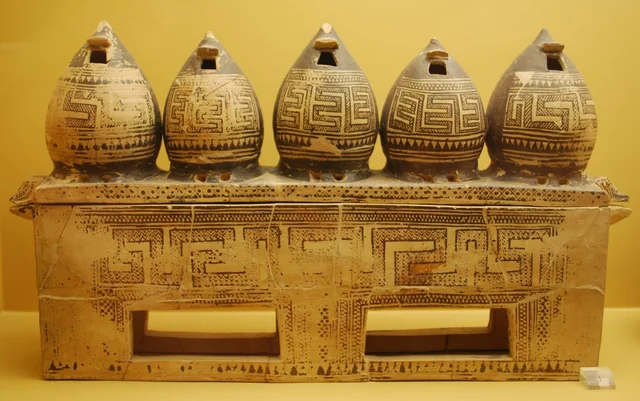
Early geometric pixis (box) decorated with five granaries. Clay
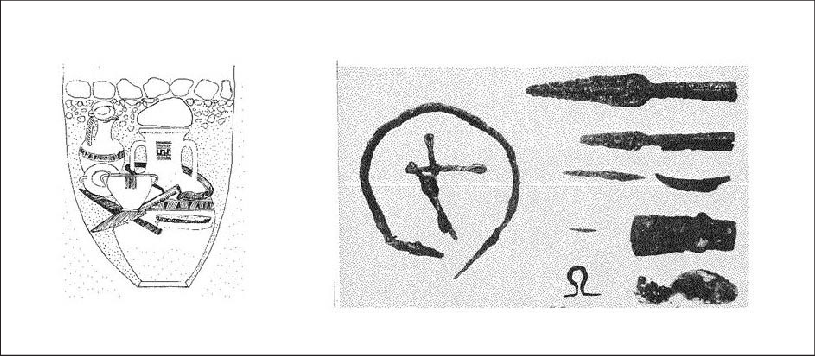
Geometric Period Grave of a warrior, buried with a spearhead and swords 850 BCE on Areopagus Hill swords are the highest metal technology, symbol of wealth and mastery. Sword is bent around the base to prevent people from grave robbing it, ancient greeks believed in everything having a spirit, so you must kill something, including objects before you bury it
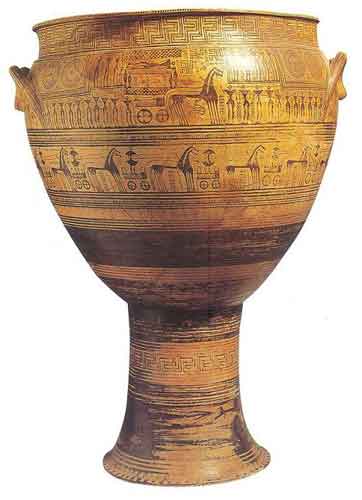
Geometric Period “Dipylon Master” an artist who made several vases in an ancient athens cemetery called Dipylon and made the most expensive vases Crater type burial urn is a vase which is wider at the top and thinner at the bottom, typically for men
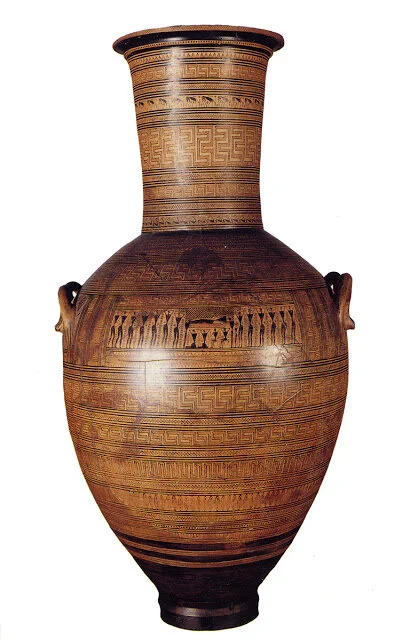
Geometric Period funerary amphora (vase with handles on both sides and is wider on the bottom) ca 760-750 BCE typically for women - vase with images of mourners
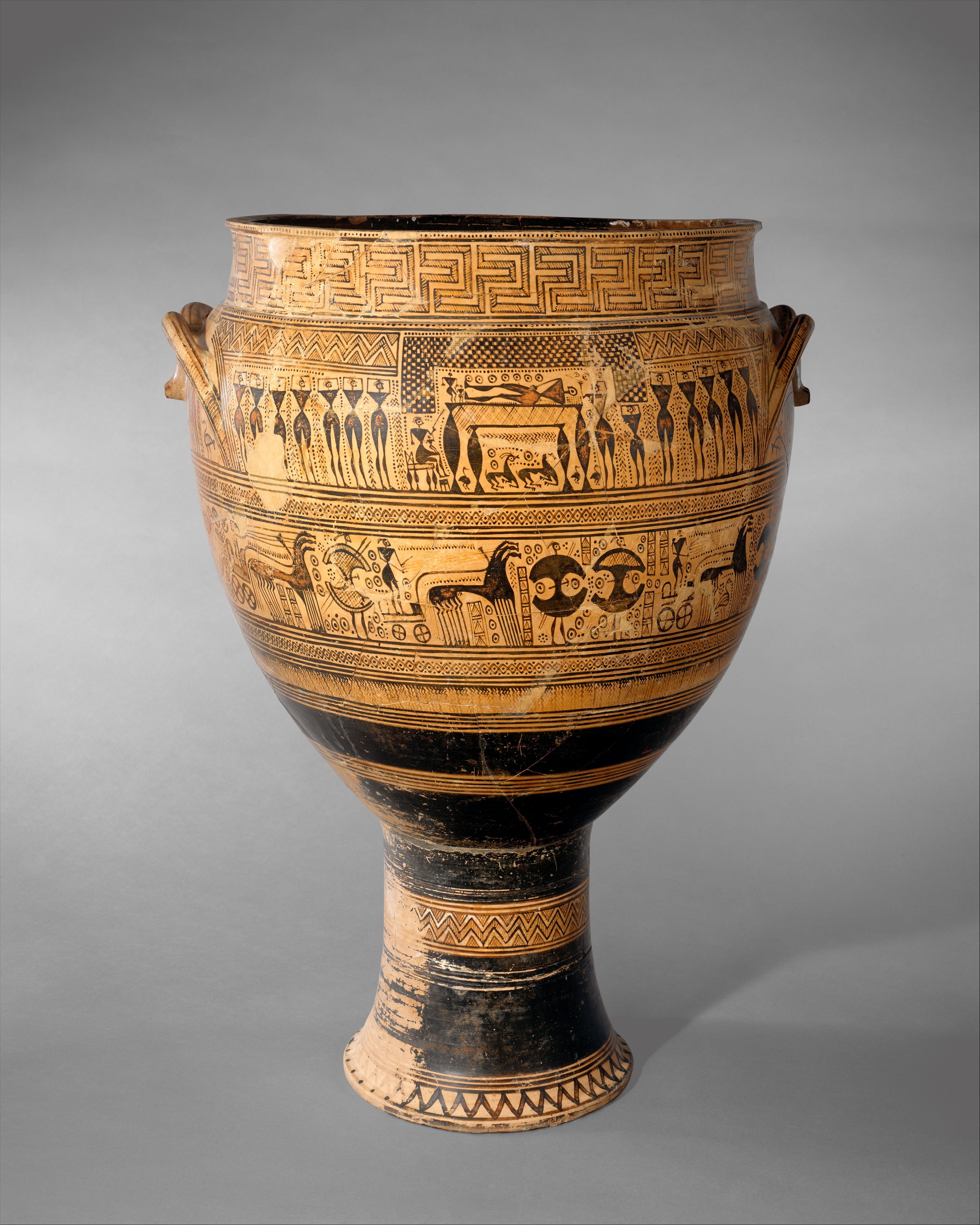
Geometric Period “Hirschfield Painter” - monumental funeral vase from Dipylon cemetery athens over 4 feet tall - funeral scene with chariots, not a war scene, it’s showing extreme sports - sports would be played at the funerals of mythical characters like Achilles and Patroclus
Hoplite
someone who carries a round shield, spear, helmet, shin guards and shoes
All hoplites bought their own armour except the spartans who did nothing but train for war because they enslaved people to do everything else
THE CITIZENRY EXISTS BECAUSE OF THE MILITARY
Adult male land owners could only be citizens because they were the only ones who fought as hoplites and as hoplites they believed they had a right to participate in the government
Phalanx
an organized group of hoplite soldiers, an infantry that moves in unison, a human tank
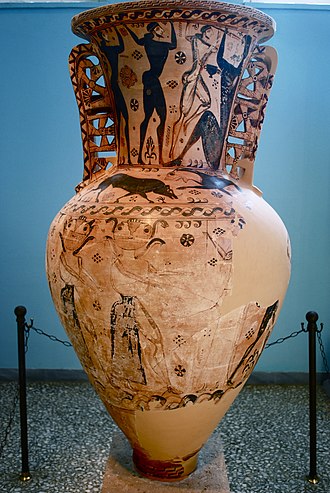
Eleusis amphora odysseus blinding the cyclops, polyphemos ca 670-650
weird medusa sisters
Orientalizing period
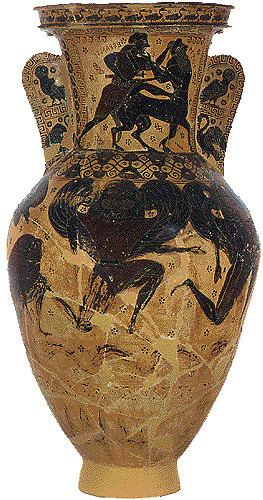
nessos vase 7th c Orientalizing period
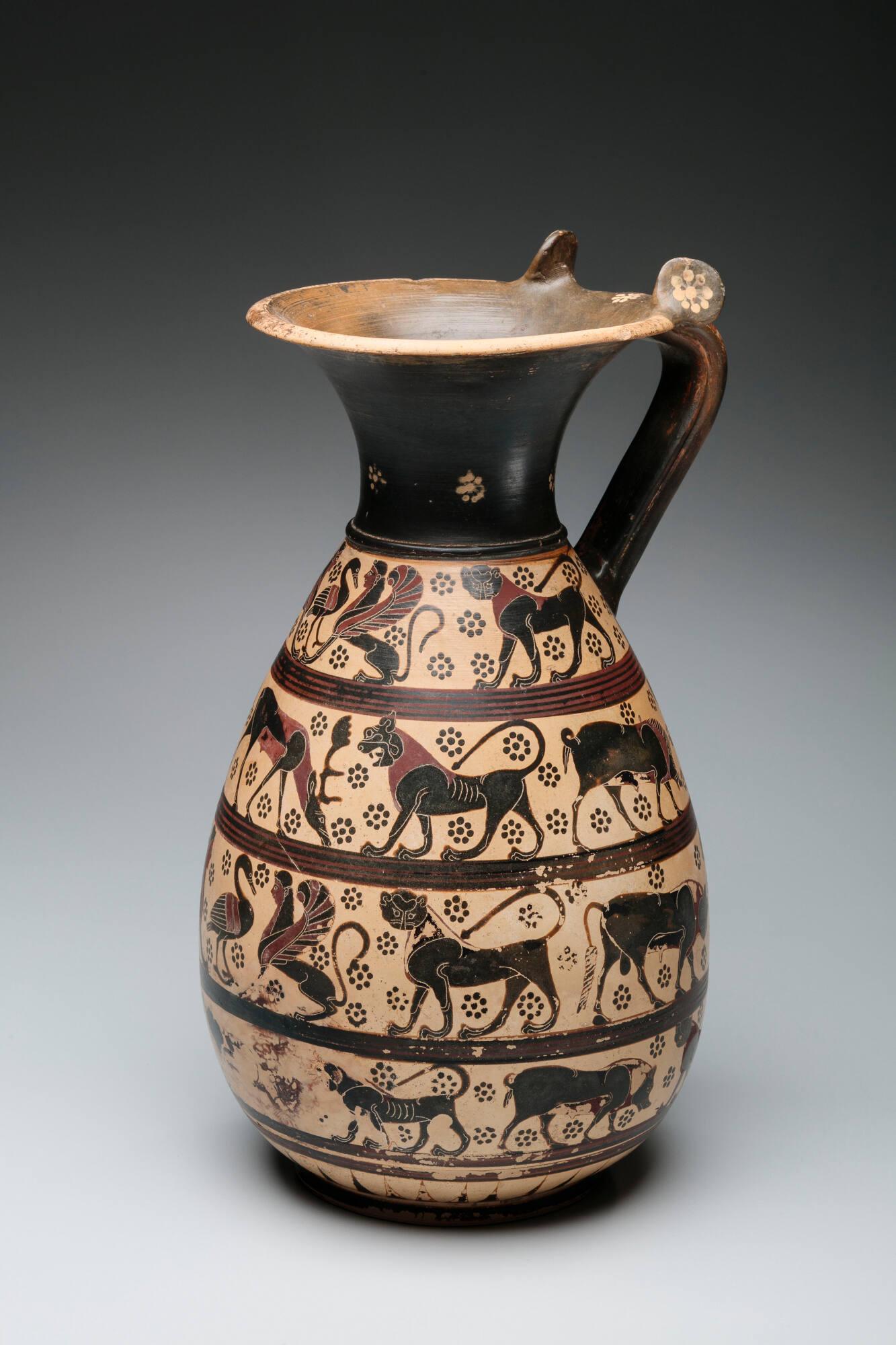
Protocorinthian olpe with four registers of animal scenes ca 680 BCE - wine jug
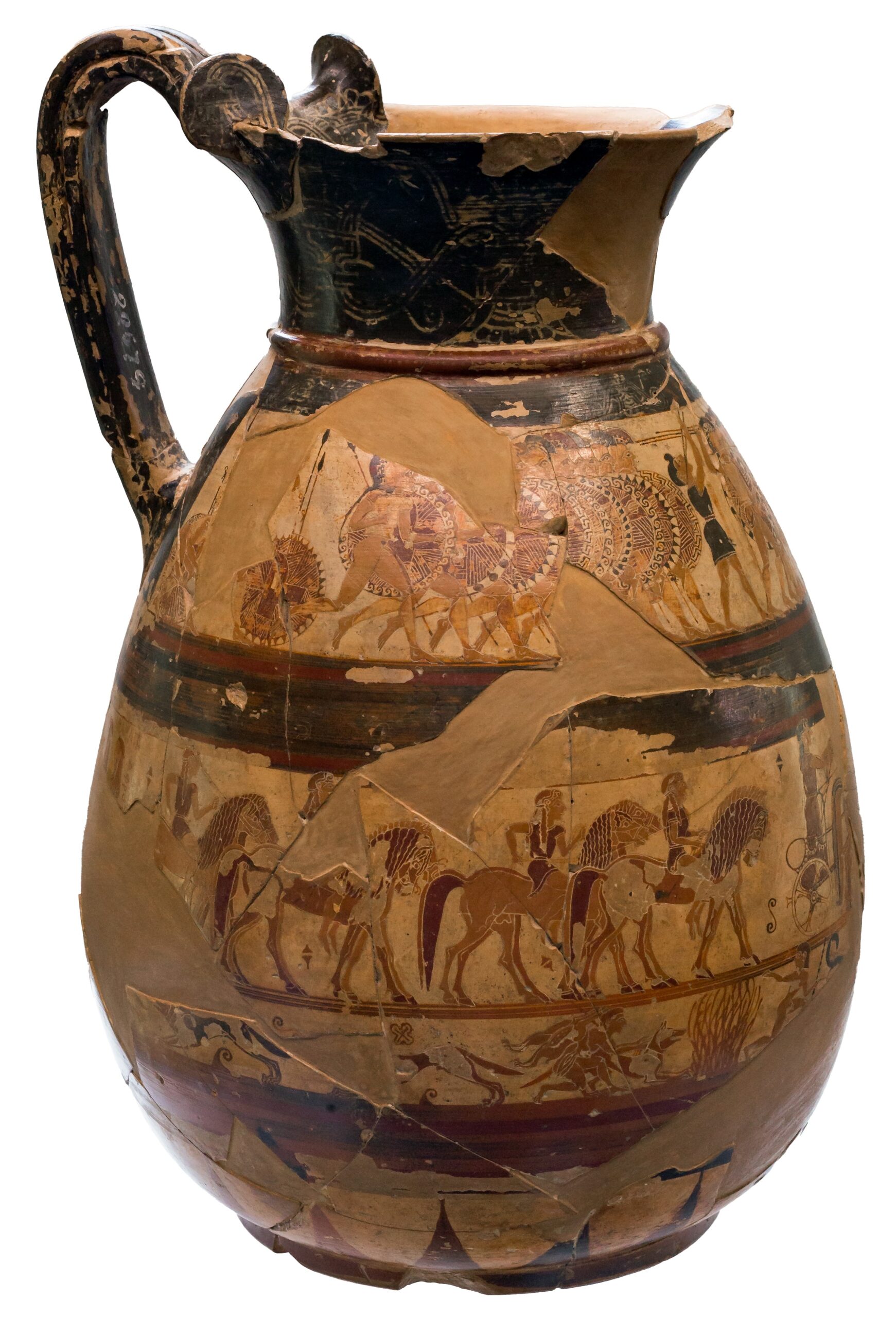
Chigi Vase, corinthian oinochoe (possibly by macmillan painter) 640 BCE
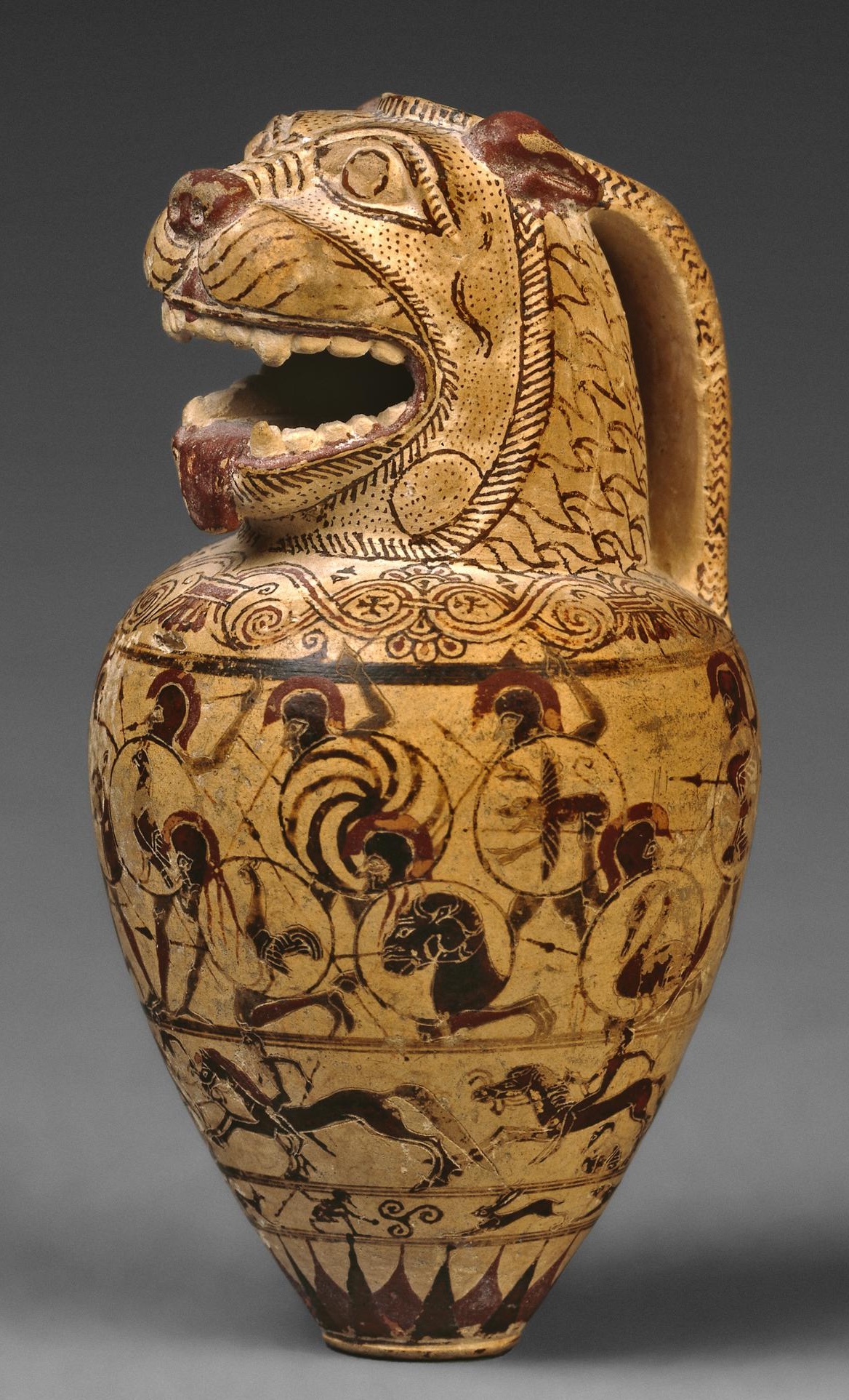
Macmillan aryballos (small vase for perfume)
Found at thebes
650 bce
Hoplites in the top register, people on horses in the middle register, people with dogs hunting rabbits on the bottom register
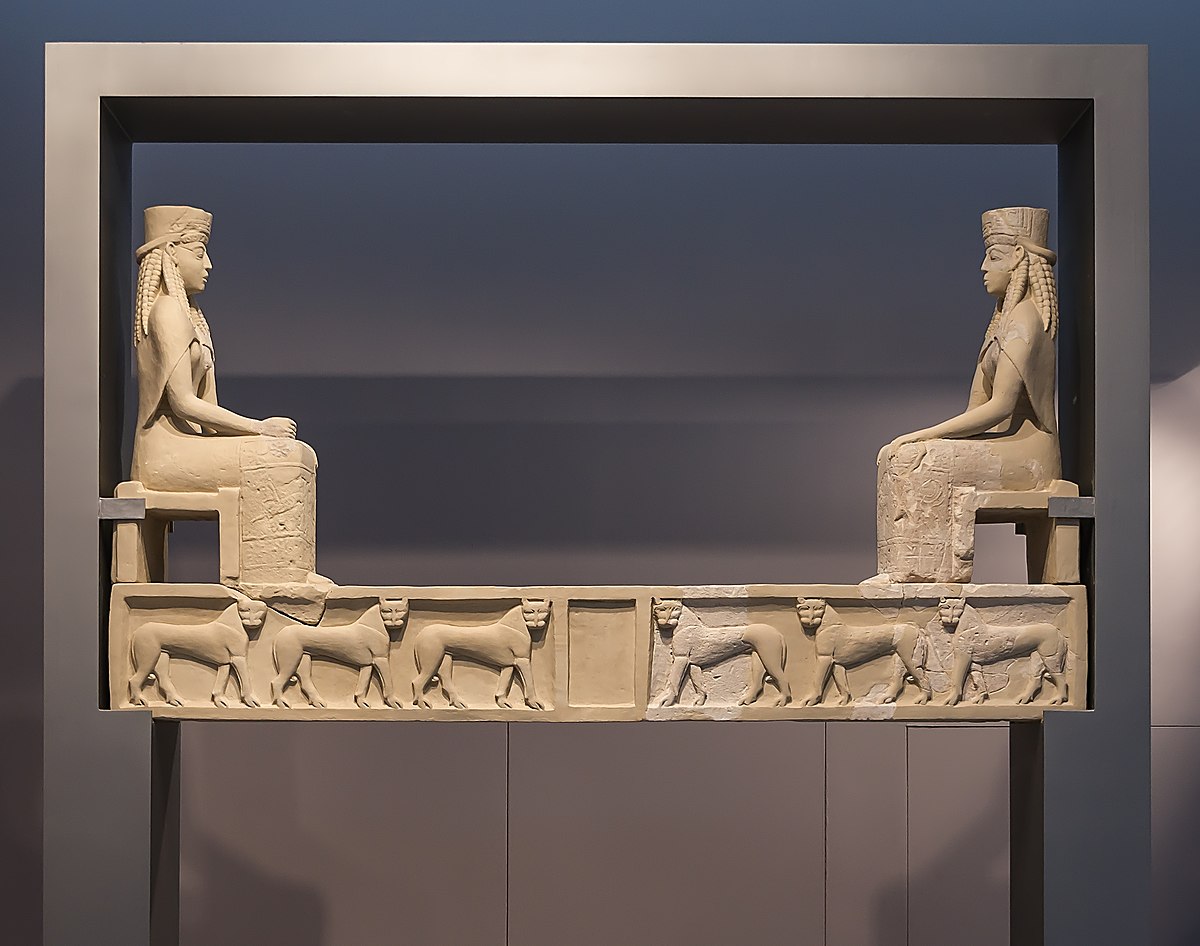
Two women and six panthers
Frieze,
post and lintel
Discuss the modern term “Geometric Period,” and one possible theory that explains what no longer extant material sources may have affected the artifacts that inspired this name.
Called the geometric period bc of geometric designs on POTTERY they’re probably copying textile designs onto vases
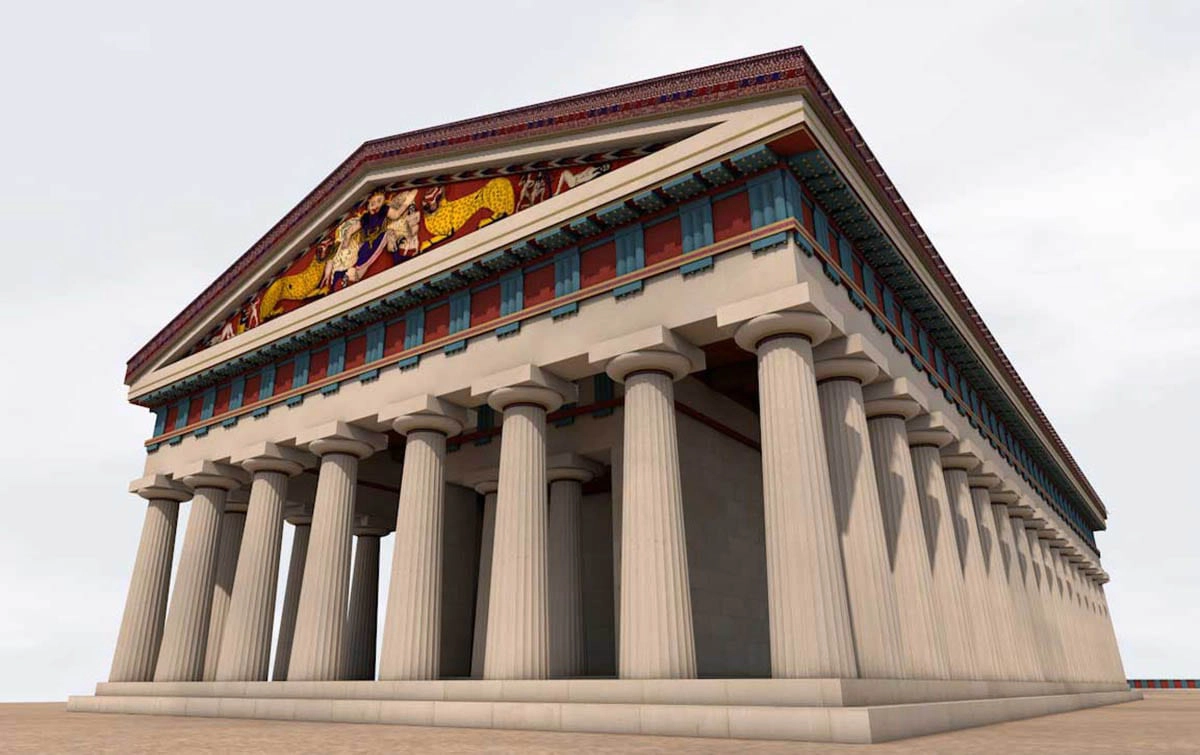
Reconstruction of the Temple of Artemis at Corfu ca 580 BCE
Gymnasium
“place of nudity,” where citizen boys trained in academics and athletics.
Describe an important theory regarding the development of the Doric Order.
An order is a series of architectural elements and decorations which work together as a unit
Stone buildings were built to replace buildings made of wood and mud brick, architectural decoration of the doric order imitates that were functional in the wooden architecture.
Skeuomorph
Doric and Ionic developed at the same time but in different places, Doric in Greece and Ionic east of Greece
Doric order developes around Corinthian areas
Doric column is a very plain column with no base and a very simple square capital
Doric friezes have triglyphs and metopes
Metopes are essentially painted tiles separated by triglyphs
nudity and power
Athletics were military preparation (boxing, wrestling, running, javelin, Male nudity = “costume of power” tied to citizenship. ● Nude male body = symbol of civic virtue and soldierly strength. ● Female nudity not depicted monumentally because: ○ Women had no equivalent civic role. ○ Greek philosophers often distrusted female beauty (seen as artificial, deceptive).
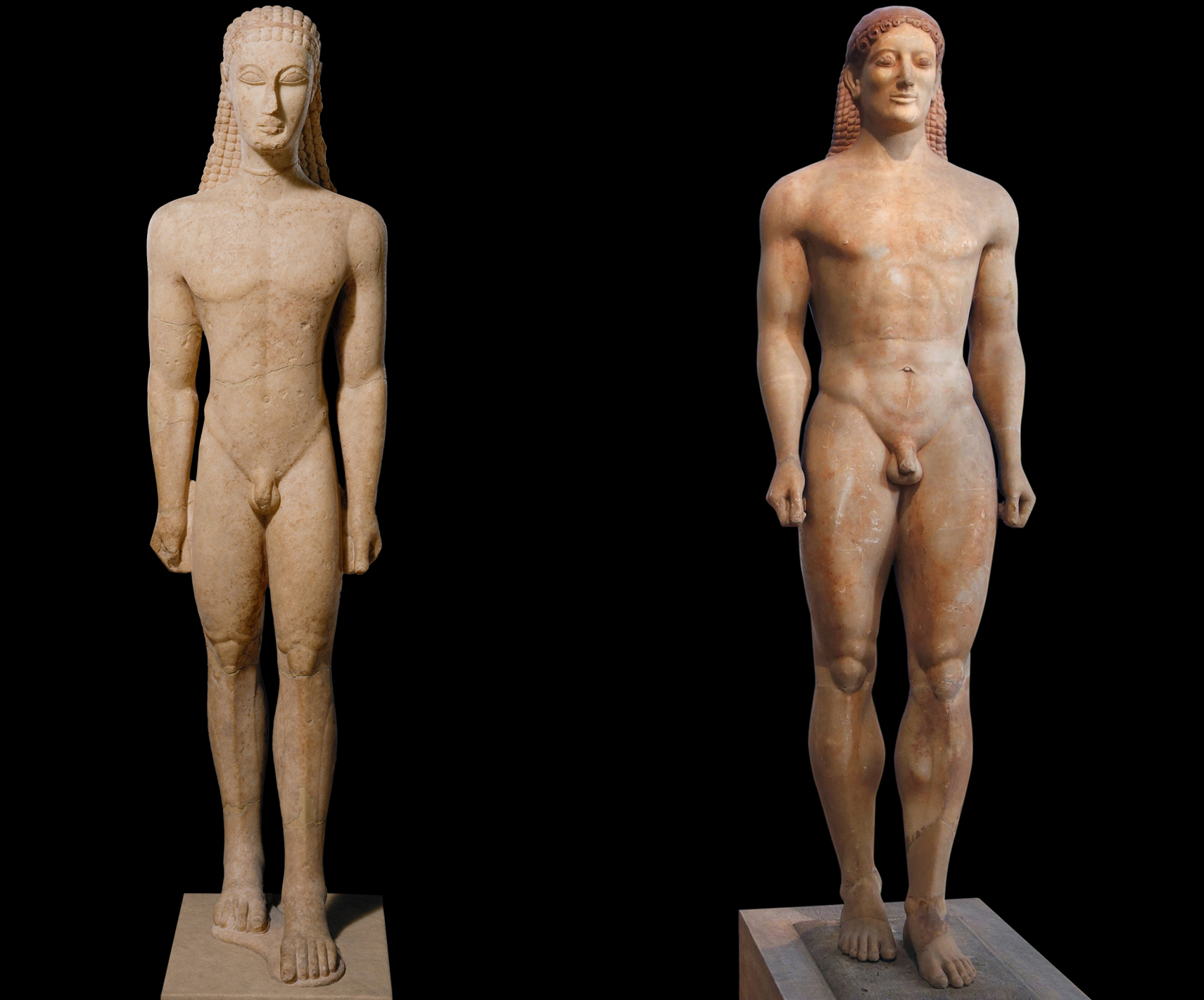
Kouros Figures Represent idealized male citizens, not portraits. ● Tell us only two things: ○ The figure is male. ○ The figure is a citizen. ● Age or likeness of the deceased is not shown.
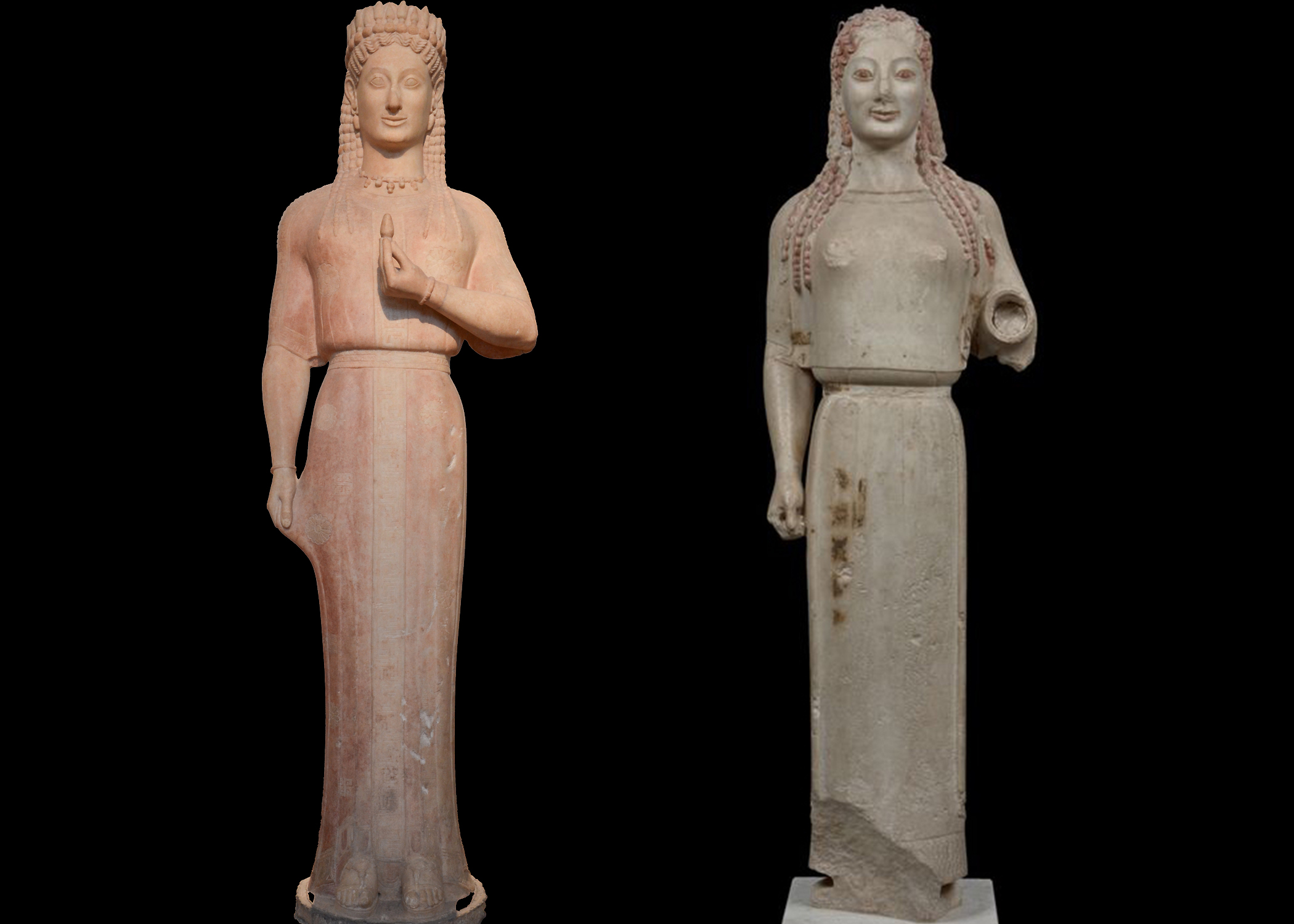
Korai Figures (Female)
Always clothed. ● Emphasize jewelry, garments, and surface detail rather than the body. ● Example: Berlin Kore (possibly had a metal coating, or red underpaint for gilding).
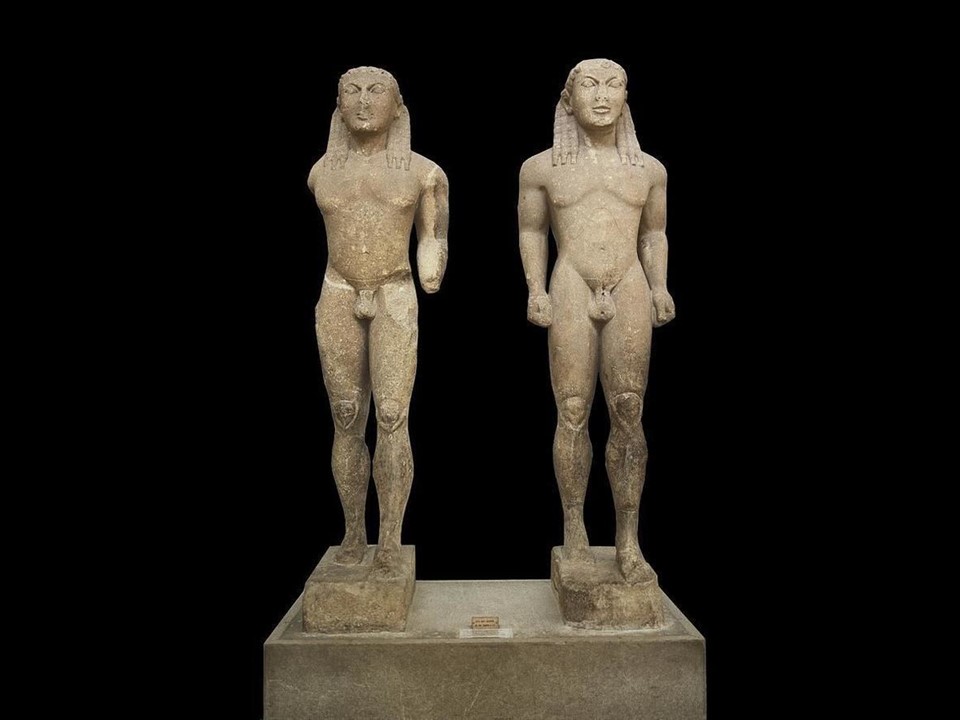
The Argive Twins Cleobis and Biton
dedicated to Delphi by the city of Argos, 580 BC, marble
Two boys carried their mother in an ox-cart to Hera’s festival when the oxen were missing. ● They died in their sleep afterward—considered the highest mortal gift (peaceful death). ● Sculpted and worshipped as heroes.
Doric vs. Ionic orders:
Doric = plain, no base, triglyphs/metopes, masculine associations. ○
Ionic = bases, volutes (scrolls), continuous friezes, more decorative.
Through the evidence of inscribed bases, we know that men as well as women dedicated Korai. Why would a man dedicate a Kore instead of a Kouros?
make an offering to a female statue or to show statue through the highly decorated clothing and jewlery of the female Korai - as male Kouros were only every sculpted naked as symbols of male beauty
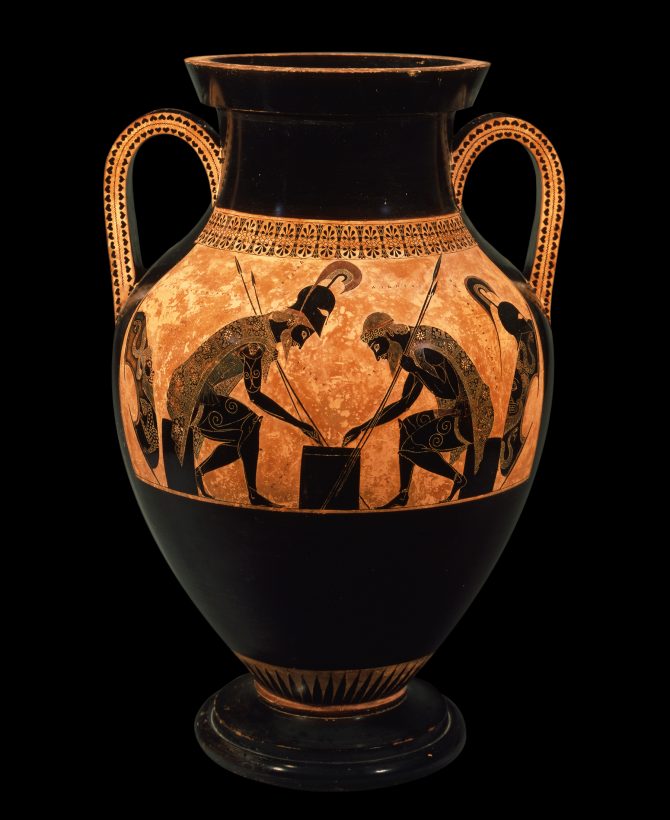
Attic black-figure belly amphora by exekias suicide of ajax ca. 540 BCE, Bologna.
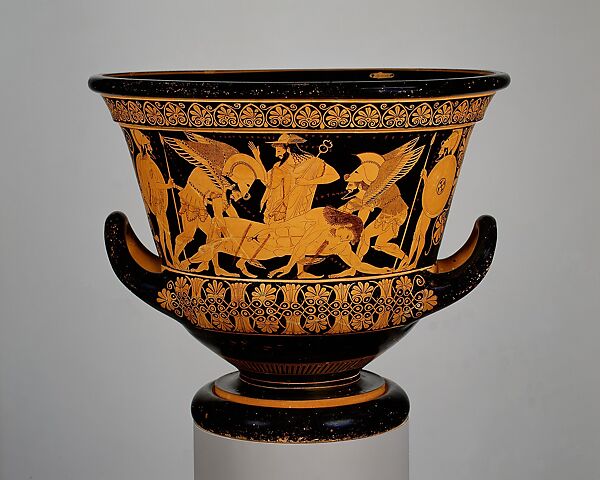
Attic red figure artist kalyx-krater pot type made by Euxitheos painted by Euphronios, depicts the death of Sarpedon and his body being carried away by gods, 515 BCE aka “Hot Pot”
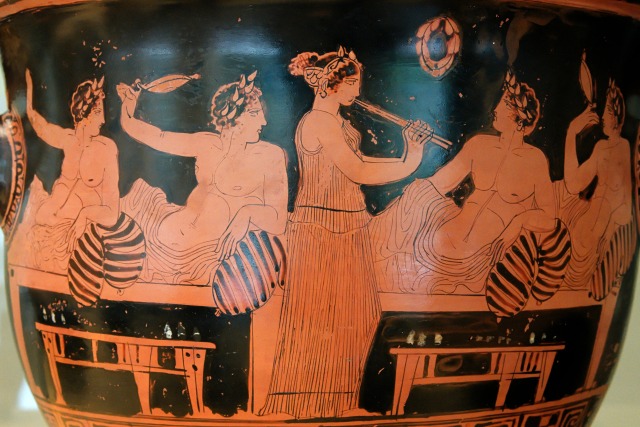
Symposion (a big men-only party) on an attic red-figure bell krater attributed to the Nikias Painter; ca. 420 BCE. Now in the National Archaeological Museum of Spain, Madrid
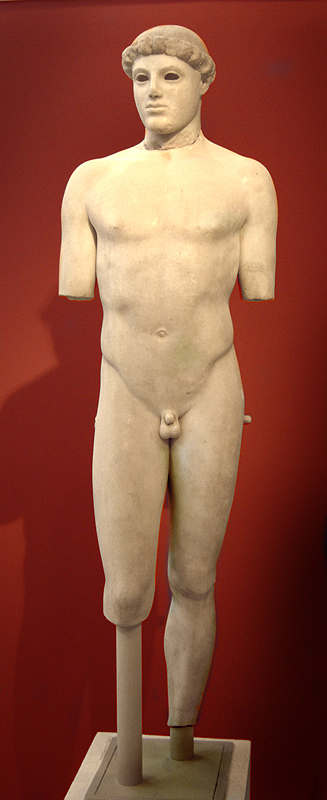
“Kritios Boy” - not by Kritios 480 BC late arhcaic period / early classical CONTRAPASTO YIPPEE
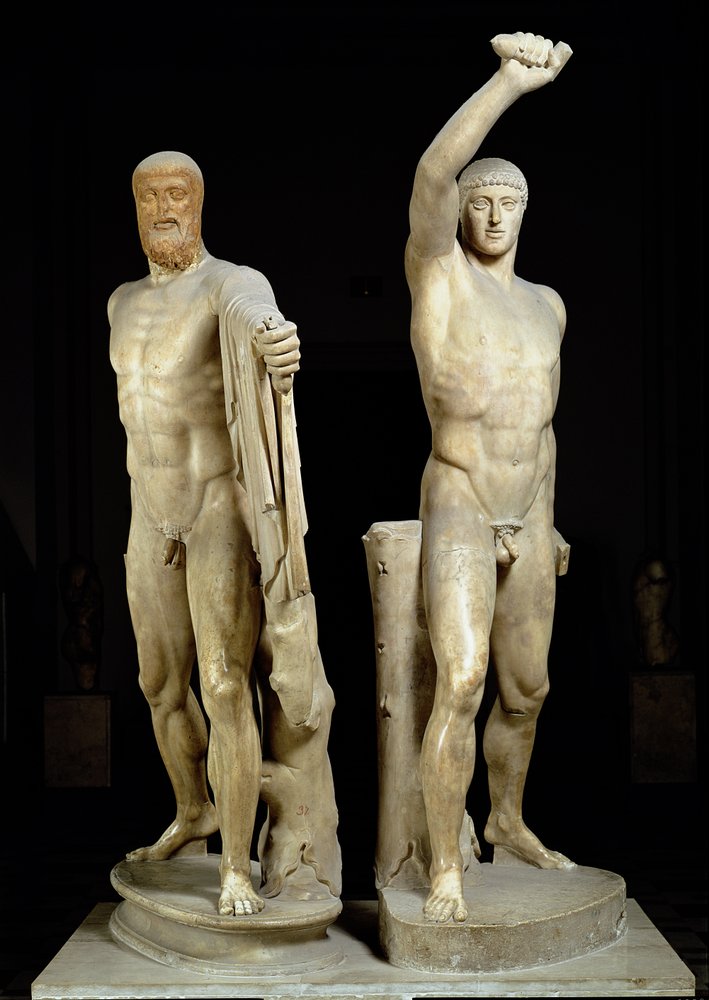
“Tyrannicides” Harmodios and Aristogeiton - roman era reproductions from Pompeii, Kritios made the originals
gay fags died to make democracy RIP Classical period
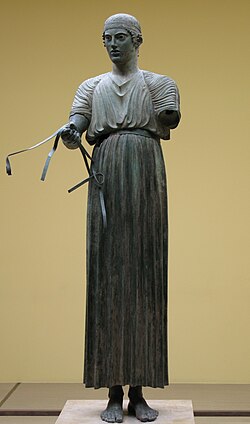
Delphi Charioteer - bronze statue which was buried under a rock slide 478 or 474 BCE for Polyzalos, Tyrant of Gela Classical period

Olympia - Temple of Zeus East pediment, zeus presides over the preparation for the chariot race between pelops and oinomaos
Discuss the sculptural program of the Temple of Zeus at Olympia. List the individual subjects. What message do the myths chosen send as an entire program?
“Sculptural program” - the decor is not unrelated, they all meet to a central theme
East Pediment -
Peloponnesian Peninsula “island of pelops”
king makes people race him to marry his daughter bc the man
West Pediment -
Fight with centaurs
Perithoos (son of Zeus) overlooks the battle
The metopes shoes the labors of Herakles (the hydra, the lion, bull of crete, artemis’ sacred deer, a boar, the belt of the amazon queen, blood sucking birds, man eating horses, had to kidnap the god of hades.
They are connected through geography, using stories which represent places all around greece, including the underworld. The decoration sends a message to the people of greece that they are welcome no matter where in greece they are from.
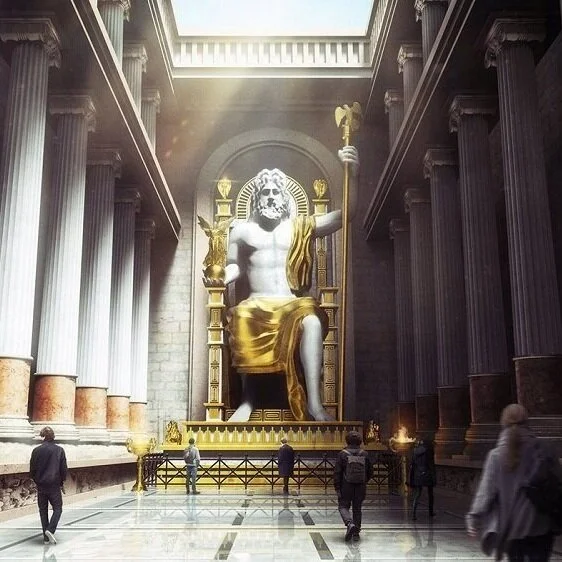
Hypothetical reconstruction of Chryselephantine (gold and ivory) statue of Zeus by Pheidias, it was 40 ft tall ca 430’s BCE
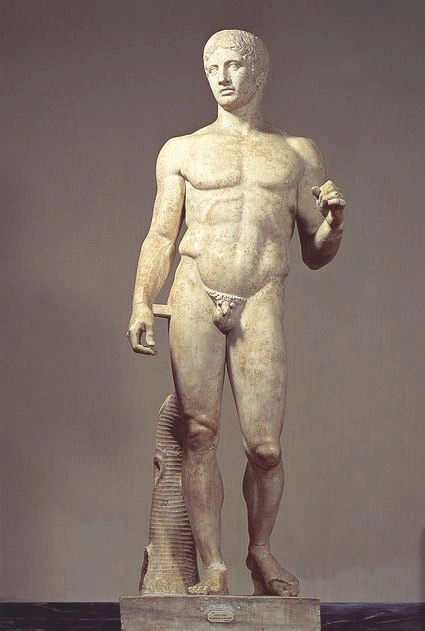
Polykleitos – doryphorus ca 450 BCE Doryphorus (spear bearer)
Original bronze did not survive we only have copies
Creating something more beautiful than the gods requires divine intervention or sight you gain that through math
Used mathematical proportions to create “perfect” bodies based off the use of maths in architecture
Wrote a book named Cannon (where art cannon comes from)
Considered the most beautiful bodies in greek art - very muscular
Sports guy
Constrapasto pose
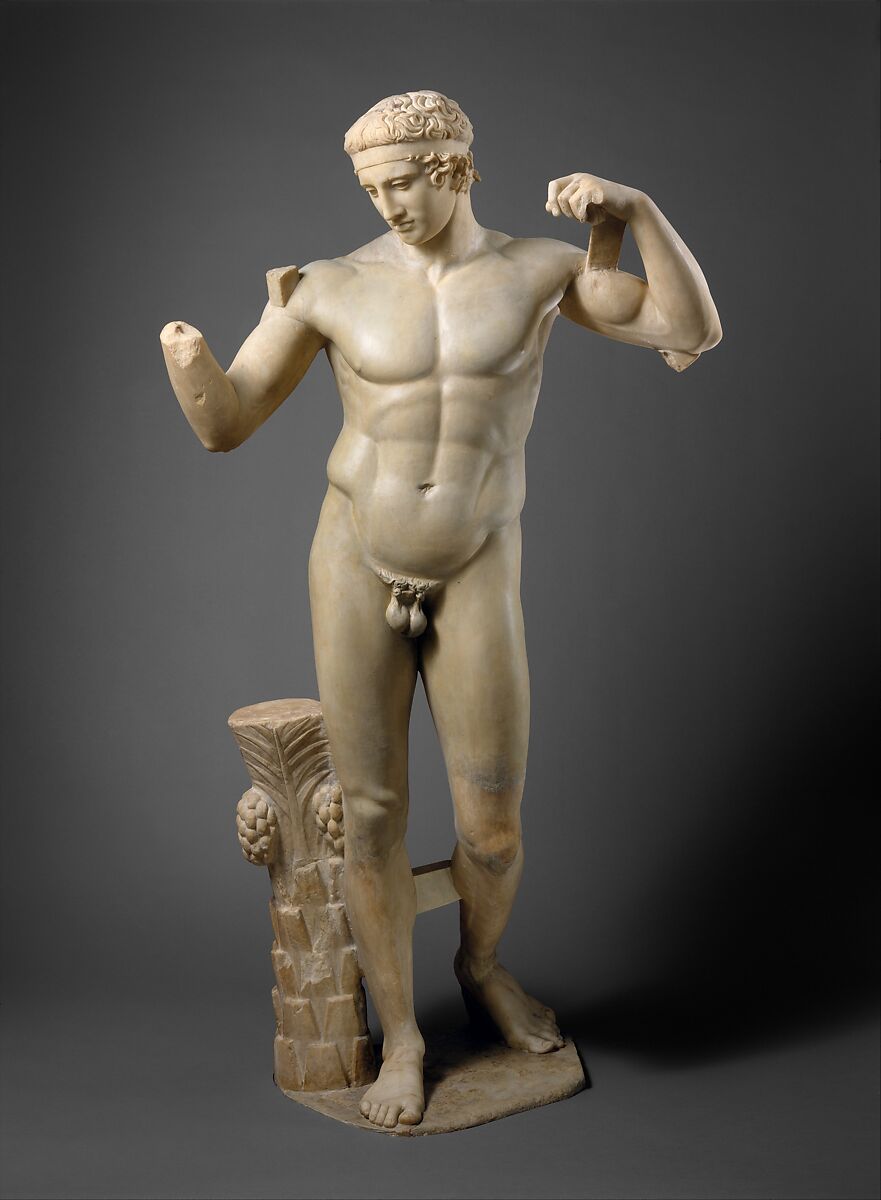
Polykleitos - Diadoumenos Ca 450 BCE
Represents victorious athlete with a headband
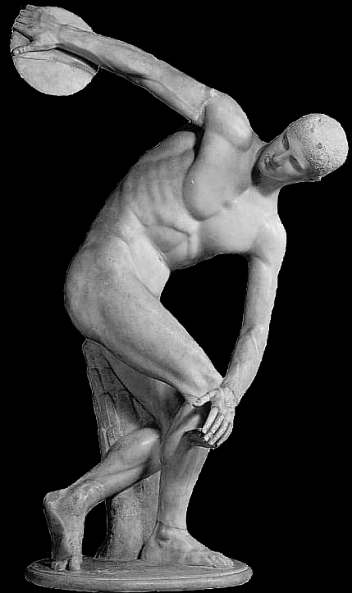
Myron - diskobolos The discus thrower Ca 450 BCE
Struts and treetrunks on statues are products of copies as the originals were bronze and more stability is needed for a marble copy
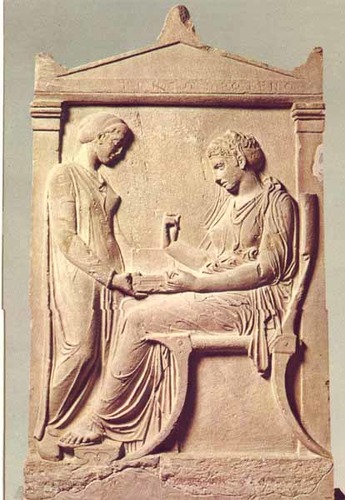
Grave stele of hegeso -athens ca 410 BCE
ATHENIAN ACROPOLIS
“Acropolis” means high city
There was a bronze age palace there before
Parthanon is not just a religious building, the real temple of Athena is in the Erechtheum
The propylaia is the entrance building/gateway
Building where there was a military museum of all the bronze weapons captured from their enemies
What was the “Parthenon style”?
It is the style of the sculptor Pheidias
Pheidias recruits the best of the best from everywhere in greece but HES the boss so he makes everyone do stuff his way and didn't let anyone put in their own styles. When these artists go back to their home workshops they no longer teach their regional personal methods they instead teach the Parthanon Pheidias style.
For the male figures the style is less ripped then the Doryphorus, more like a runner. Taller and skinnier - they said Pheidias was the sculptor of gods and Polykleitos was the sculptor of athletes.
For the female figures the fabric was very bunched up, fabrics was a place for sculptors to play with abstraction - wet fabric where anatomy is still visible underneath unnaturally folded fabrics. There is an actual interest in female anatomy for the first time.
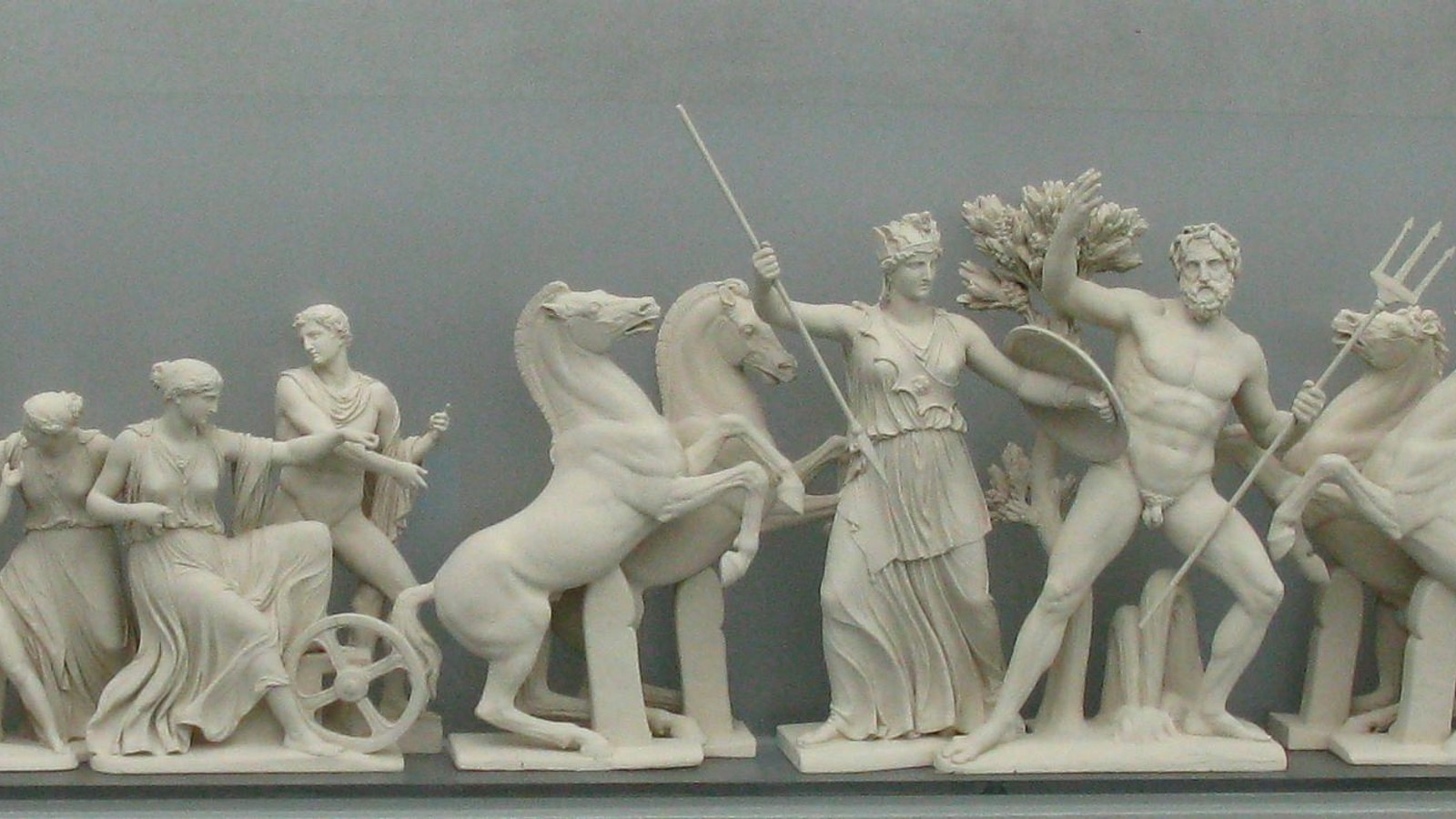
Bad reconstruction of the west pediment - the story is a chariot race over who will be the deity that athens belongs to - athena vs posidon - when they cross the finish line they slam their weapon into the ground, when Athena’s spear hits the ground it sprouts an olive tree, and when Posions’ trident hits the ground it sprouts a freshwater spring.
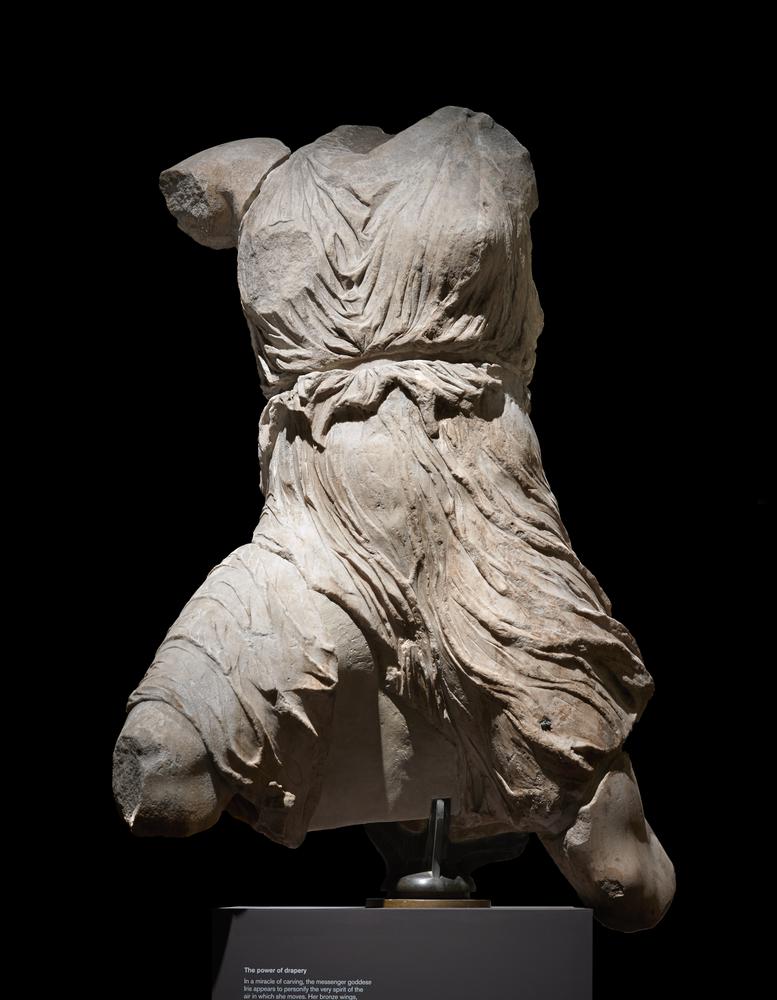
Iris torso on the west pediment - wearing a short skirt as she is a god who flies
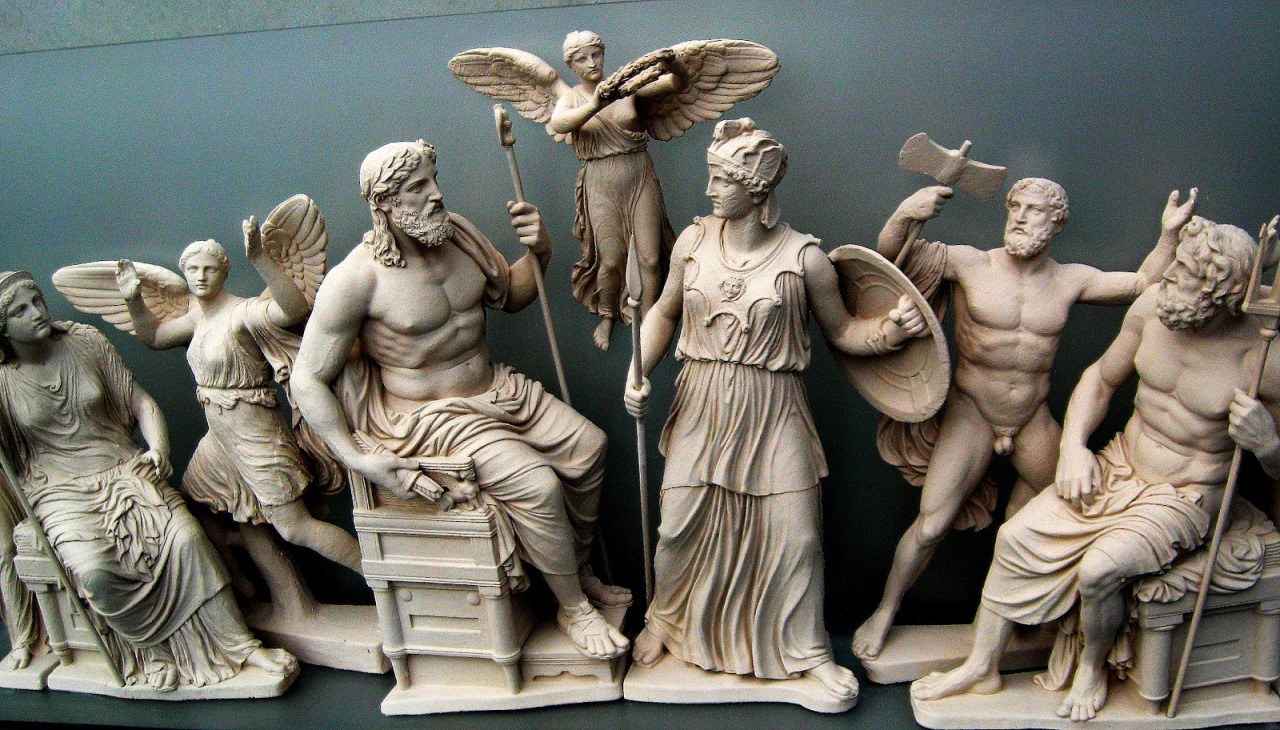
East pediment shows the birth of athena-
There was the goddess of thought who was very hot ( a thot), and there was a prophecy that her child would be more powerful than the father, Zeus Poseidon and Hades all swear not to have sex with her cause none of them want to be replaced - Zeus sleeps with her and she's now pregnant. Zeus tries to fix this by eating her but one day he gets this horrible headache - he gets someone to hit him in the head with an axe and out of his head pops athena.
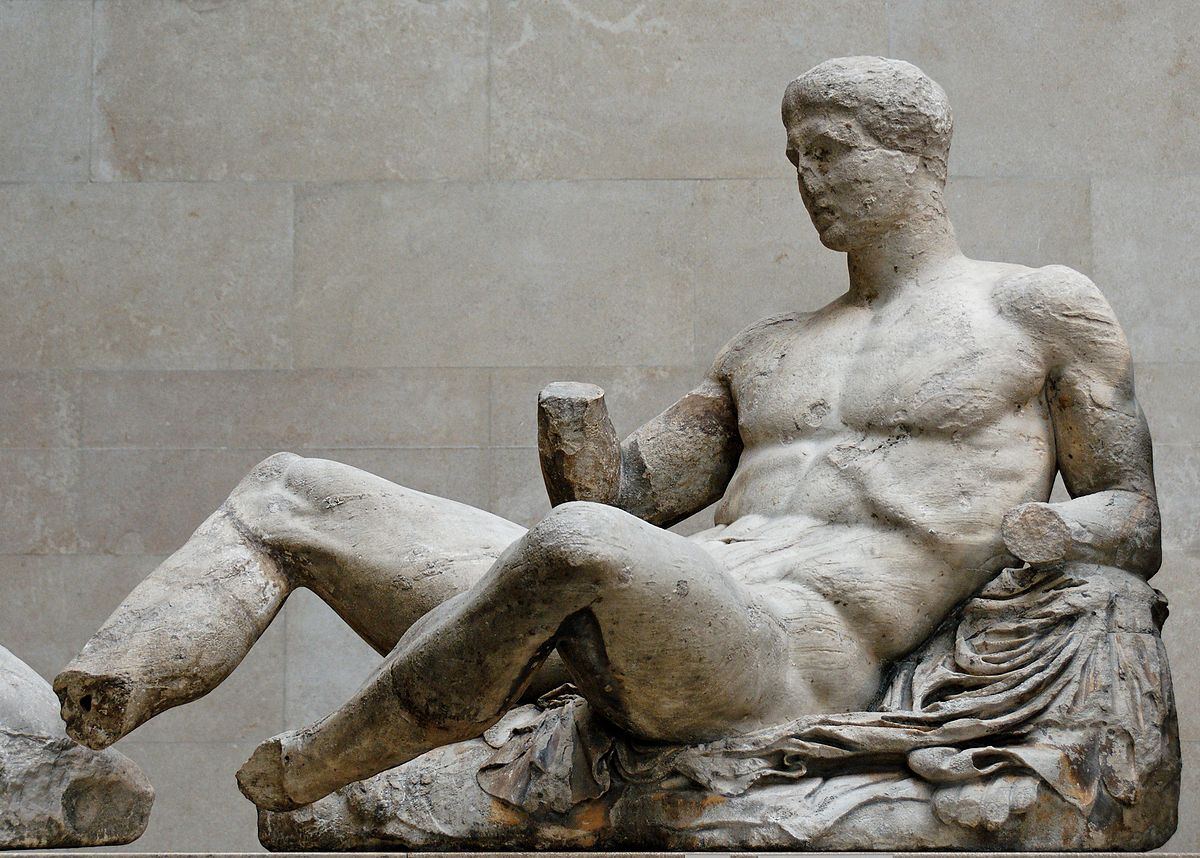
Statue of dionysos on the east pediment
Was the Parthenon mainly built as a place of worship? Provide evidence.
NO!! It is a temple shaped building
There is no altar associated with the parthenon, though perhaps they used the other altar from the other building
There was no priest or priestess of the Athena parthenos (athena the maiden), and we have many lists of other priests and priestesses for other gods
There is Athena Polios (athena of the city) and she is worshiped in the building next door, so maybe the same priest took care of both buildings
There were many votive offerings to Athena polios but none to Athena Parthenos, so this pretty much proves the Parthenon was not mainly a temple
So what is it? It is a victory monument for the Persian wars, and it is a treasury, where they keep their gold. They kept gold in statue form because it was more difficult to steal.
During the heleneistic period (post alexander the great) there was a Macedonian king Dimitrius who came to Athens and forced himself to be their ruler, during this time he lived in the parthenon which was disrespectful to the state of athens but not considered blasphemy.
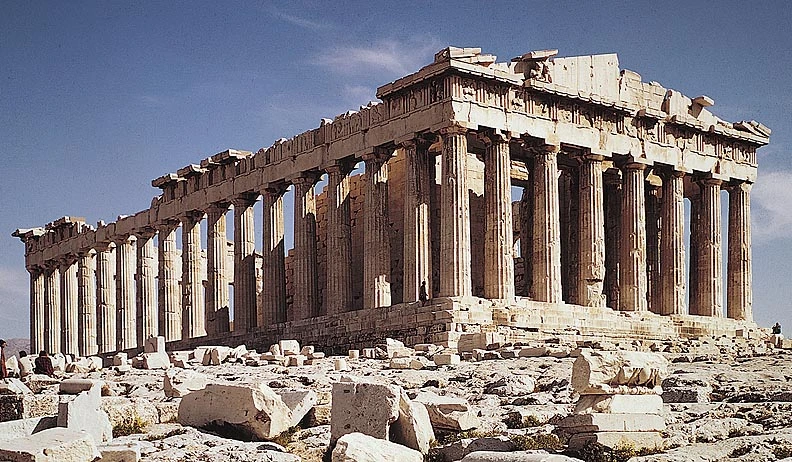
The Parthenon, Athens 448-432 BCE
Architects: Iktinos and Kallikrates
They are career architects, we know other buildings they made
Project Manager/Sculpture: Pheidias
Pheidias is in charge of the architects
Pheidias got the job to make the statue of zeus at olympia
Parthenon is in good shape for what happened to it (it exploded)
Parthenon is famous because it is covered in sculpture it has 92 metopes sculptures and pediment sculptures
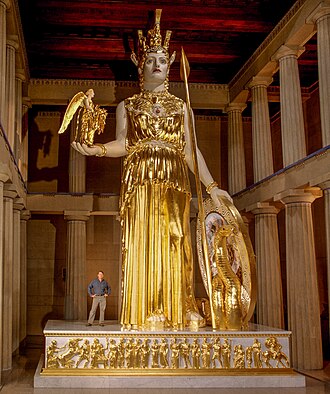
Athena Parthenos
the varvakeion a roman period 2nd century marble miniature of the phiedian statue of athena parthenos completed ca 432 BC
A full scale replica of the statue was made in nashville TN by Alan LEquire
The og was made of gold and ivory
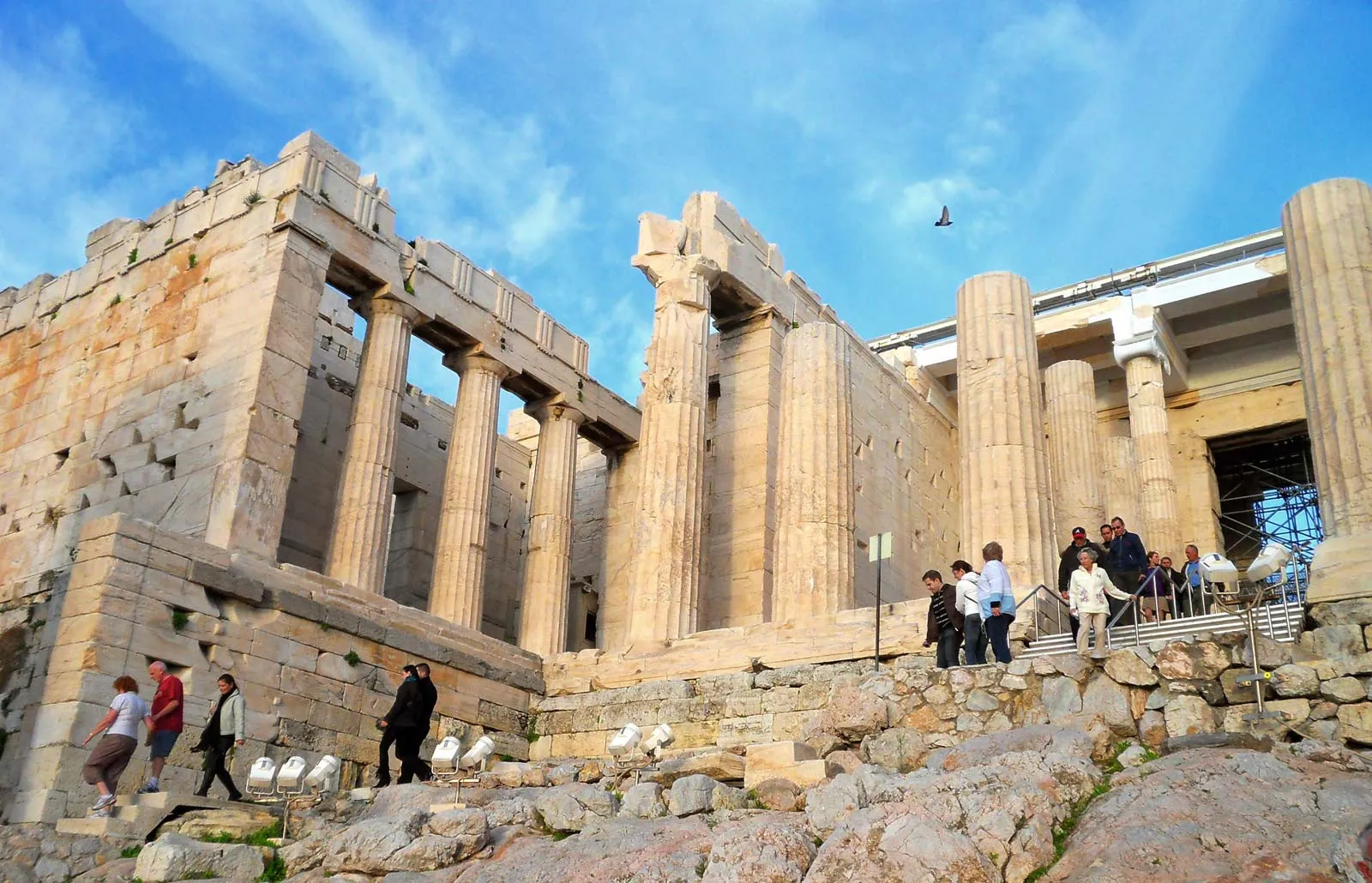
PROYLAIA Mnesikles is the architects of Proylaia (a building with five gates which leads up to acropolis) 437-432 BCE
He was probably told not to build the south wing and he did it anyways to spite them.
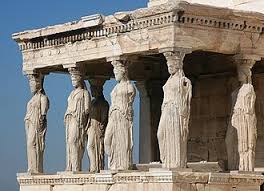
The Erechtheion was built 421-405 BCE and was where Athena was actually worshiped, where the wooden statue was worshiped.
The porch of the maidens!!! The Korai are six female shaped columns - we believe they are representative of the daughters of king Kicrops
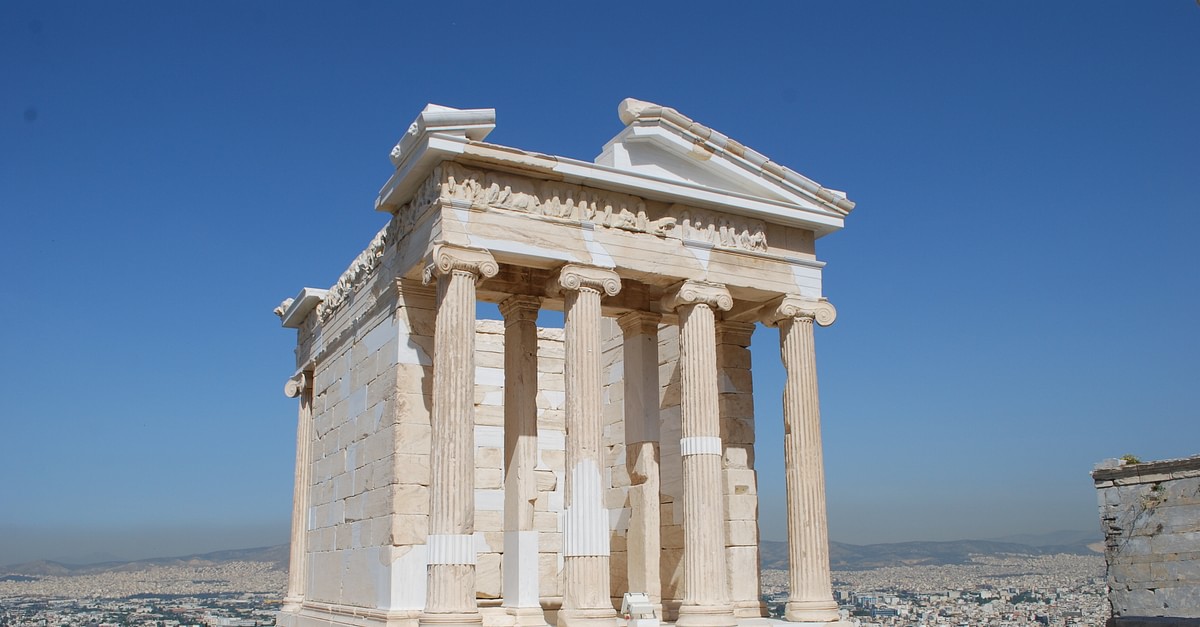
Temple of athena nike is very small - architect Kallikrates - ca 420-413 - newest building - base for the sculpture ontop is huge, larger than the one on the parthenon